DEBUNKING
MAINSTREAM
MEDIA'S LIES ABOUT OIL
FTW's
Dale Allen Pfeiffer Goes Head to Head With Pulitzer
Prize Winner Daniel Yergin
By
Dale Allen Pfeiffer – FTW Contributing
Editor for Energy
[© Copyright
2003, From The Wilderness Publications, www.fromthewilderness.com.
All rights reserved. THIS IS A SUBSCRIBER-ONLY STORY
AND MAY NOT BE POSTED ON A WEB SITE WITHOUT EXPRESS WRITTEN
PERMISSION. Contact media@copvcia.com. This story may be redistributed,
circulated or copied for non-profit purposes only.]
The word about peak oil has barely reached
the surface of the major media, and already there are
many experts shouting loudly that this is not true. As
the crisis worsens, we will no doubt see more and more
experts claiming ever more loudly that there is no problem
at all. And we will likely hear more claims about the
benefits of a transition to hydrogen fuel cells, fusion,
nuclear fast breeders, and other more exotic technologies
(such as zero-point energy). All of this hype may pacify
people and prevent them from realizing what is actually
happening, but it won't reverse decreasing oil production
nor lead to meaningful alternative technologies. If there
is a magic bullet solution for Peak Oil, it has not yet
been demonstrated in a way that permits independent verification
or establishes a significantly positive Energy Return
for Energy Invested (EROEI).
One example of the disinformation being
fed to the public by the mass media is an article written
by Daniel Yergin published in The San Francisco Chronicle (Sunday,
April 13, 2003).1 Evidently, the Chronicle was so
swayed by Yergin's name that they forgot to check the
facts behind his story.
Though Daniel Yergin is considered to
be an authority on international politics, economics
and energy, he is neither a scientist nor an engineer.
Despite this lack of credentials, Daniel Yergin was awarded
a Pulitzer for his book The Prize: The Epic Quest
for Oil, Money and Power, and he is currently a member
of the Board of the United States Energy Association,
the National Petroleum Council, the US Secretary of Energy's
Advisory Board, and the US Department of Energy's Task
Force on Strategic Energy Research and Development. He
is also a member of the Committee on Studies of the Council
on Foreign Relations and a Foreign Associate of the Royal
Institute of International Affairs.
With all of these credentials, one might
wonder how he could author an article which is so misleading.
However, I have seen him in action, arguing with several
of my colleagues, and I can state that the man is a true
cornucopian. He will not recognize any data that might
shake his faith in Neoliberalism or free market economic
theory. No doubt, he will consider this article to be
rubbish, if he even bothers to read it.
In his article for the SF Chronicle,
Mr. Yergin claims that Iraqi oil counts for such a small
percentage of the global oil picture that its influence
on oil markets is negligible. In fact, he downplays the
significance of all Middle Eastern oil. Let us take a
look at Mr. Yergin's claims and compare them with documented
studies and factual reports.
To inflate his data on oil reserves,
Mr. Yergin accepts industry and EIA (Energy Information
Association) figures without question (rather like
the embedded journalists reporting on the invasion
of Iraq). He refuses to backdate discoveries (account
for the fact that oil companies routinely under-report
new finds to reduce taxes) and he accepts inflated
numbers for Caspian reserves even as the oil majors
pull out of the area for lack of interest. But one
of the most interesting techniques he uses to inflate
his data is to include all hydrocarbon deposits regardless
of source or extraction techniques. Whether tar sands,
deep sea deposits or conventional oil, it is all one
to Mr. Yergin.
Never mind that harvesting tar
sands is energy and water intensive. Tar sands are
extracted and processed utilizing stranded natural
gas.(Small pockets of gas that are not profitable to
pump at current prices). But as the price of natural
gas has increased, so has the price of using NG to
harvest and process tar sands. As natural gas prices
rise, the stranded gas is sold in the marketplace leaving
little for tar sands. Industry analysts have all but
admitted that North America is falling off the natural
gas cliff (i.e. natural gas reserves are almost empty).
Allowing for seasonal changes, the price of NG will
only increase from now on.2 3 Tar sand processing also utilizes
a vast quantity of water. Production has heavily taxed
local aquifers and left large retention ponds of tainted
water needing to be purified at an energy and economic
expense. Due to these factors, various companies are
beginning to cancel tar sands projects or place them
on hold.4 Beyond
this, tar sands are harvested by strip mining, not
by pumping. Production from tar sands comes at the
additional cost of destroyed landscape, and the additional
expense of remediation and waste disposal. And in any
mining operation, there is always a notable portion
of the resource that is deemed unrecoverable, either
because the seam is too small, or because of fault
or other physical factors that limit the viability
of production.
For all these many reasons and more,
tar sands and other unconventional forms of hydrocarbons
should be considered separately from conventional oil.
Once conventional oil production begins to decline worldwide,
non-conventional production will be constrained by the
rising price of energy input. Furthermore, even if unconstrained,
non-conventional sources will not replace conventional
oil, they will only help to ease the decline. The following
graph, based upon the most current of data, incorporates
non-conventional sources into the energy picture.
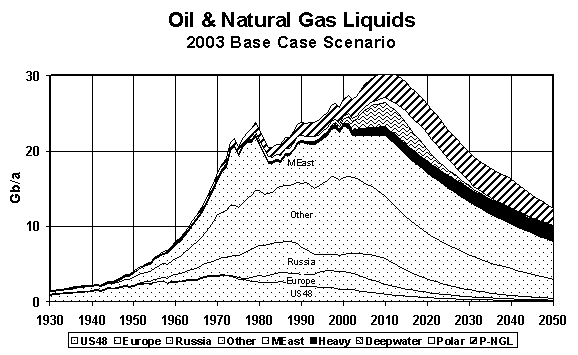
From
the ASPO Newsletter; graph developed by Colin Campbell.
http://www.asponews.org/
If we exclude non-conventional
sources and look only at conventional oil the figures
change---giving us a much clearer picture of the importance
of Middle Eastern oil, and of Iraqi oil. Instead of
the 3% figure given by Mr. Yergin, the accepted figure
for Iraqi deposits hovers around 7% of worldwide conventional
oil reserves.5 In
their 1998 paper, The World Petroleum Lifecycle,
Richard Duncan and Walter Youngquist state that Iraq controls 7.3% of the oil reserves in the top 42 oil producing nations.6 World Oil reported that Iraq contained 115 billion barrels of known reserves in 2002; the Oil & Gas
Journal reported 112.5 billion barrels for the
same year. Colin Campbell estimates 118 billion barrels
of known reserves. Given known world reserves of 1767
billion barrels, this comes out to about 6.7% of world
reserves.7
Mr. Yergin states that Iraq and the entire Middle East are not very important to US oil consumption, noting that the US gets 70% of its crude supplies from its own production or from neighboring
countries in North and South America. According to
the latest data from the EIA, the US consumes 19.6 million barrels of oil per day (million bbl/d). US production at 8.1 million barrels per day (and falling) only accounts for 41%
of demand. Mexico (1.46 million bbl/d) supplies 7.4% of our demand, and Canada (1.37 million bbl/d) another 7%. This brings us up to 55.4% of US demand.8 It should be noted that Mexican production peaked in the last
couple years9 while Canada appears to be peaking right now.10 The
entire North American region peaked in 1985.11 Venezuela (1.14 million bbl/d) adds another 6% to our picture, bringing regional imports
up to 61.4% of US demand.12 Adding in Colombian and other American sources
might bring us up to 65% of US demand, not quite the 70% of Mr. Yergin's boast. And we must bear in mind that
Latin America is at peak production right now, so
their capability of meeting our demand is going into
decline.13 14
Compared to this, Iraq's contribution to US demand (449,000 bbl/d) seems to be but a paltry 4.2% of
total US demand.15 However, Iraq is one of the few countries in the world with the capacity to increase its
output. When we add this current import data to Iraq's neighbor Saudi Arabia (the top source of US imports at 1.49 million bbl/d) we find that the US is dependent upon these two countries for 11.8% of its oil demand, or 20.1%
of its imports).16 Moreover, these two countries
will be among the last to reach peak production (Saudi Arabia in 2013 and Iraq in 2019).17 Regionally, the Middle East will be the last area
in the world to peak in oil production, probably
around the year 2014.18 Every other region in the world
has already peaked in production. Soon declining
production in all other regions will result in what
has been termed “the crossover event”. Beyond this
point, Middle Eastern production will make up for
the difference between demand and declining production
until this region also peaks.
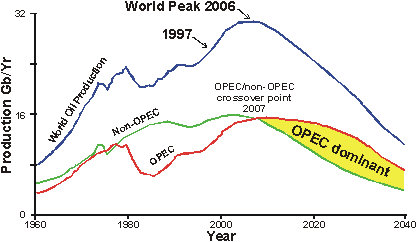
The
OPEC crossover point in world oil production.
Duncan & Youngquist. http://www.dieoff.com/page133.htm
It is in this light that the
Middle East, and Iraq in particular, demonstrates its true importance. Control of Iraqi oil would
be most useful in thwarting OPEC, and in an attempt
to prevent the oil market from converting to the Euro.
Yet, Mr. Yergin tells us that
oil has nothing to do with the invasion of Iraq. Mr. Yergin insists on the party line that this is about weapons of mass destruction.
Isn't it interesting that we
have yet to find a weapon of mass destruction in Iraq? Oh yes, I forgot, the weapons of mass destruction were not in Iraq;
Saddam Hussein hid them in neighboring Syria. In any case, we have control of the country now, and we can begin to build
a safe democracy for the people of Iraq. Let's begin the process by encouraging the Iraqi people to loot the various
ministries and museums full of antiquities. Ah, but
we will protect the valuable records of the petroleum
ministry.
Come on Mr. Yergin, do you really expect
us to believe that this invasion was not about oil?
No, Daniel Yergin insists, new
sources of oil have limited OPEC's clout over the last
couple of decades and more oil is being found all the
time. He points to the North Sea, Alaska, Russia and that greatest of all oil mirages—the Caspian Sea.
North Sea
The North Sea oil
fields belong to the countries Norway and the United Kingdom. The United Kingdom pumped its fields vigorously, utilizing all the latest technology. As a result,
they squandered their oil very quickly, and did such
a thorough job of it that their depletion rate (currently
6.1%) gives the downward side of their production curve
the shape of a cliff rather than a gentle slope. The United
Kingdom peaked in 1999. They will be lucky to produce 720,000 barrels per day by 2020.19
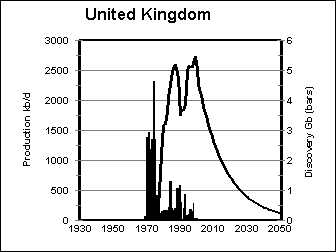
United
Kingdom Production Curve (with discovery as a bar graph),
courtesy of Colin Campbell.
http://www.asponews.org/ASPO.newsletter.020.php#83
Norway has perhaps
the best documented oil fields in the world. And in
the last couple of years, they have very honestly admitted
that their oil fields are peaking. They have not exploited
their fields as thoroughly as the United Kingdom. However, the effect of modern pumping technology can still be plainly seen
in their production statistics: production was brought
up quickly, the fields had a relatively short life,
and the depletion curve is steep. Norway's
production peak is occurring this year (2003). Their
depletion rate is currently 7%. By the year 2020, they
will be lucky to pump 900,000 barrels per day.20
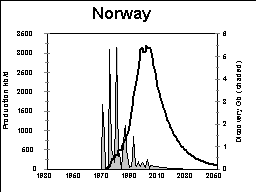
Norway
Production Curve (with discovery in gray),
courtesy of Colin Campbell.
http://www.asponews.org/ASPO.newsletter.025.php#129
Alaska
Discovered in 1969, the giant
Prudhoe Bay field added 13 billion barrels of oil to
US reserves just when it was sorely needed. However,
this field was exploited using the latest technology
and was soon depleted. Overall, it did not change the
production peak for the US, but it did give the country a secondary (smaller) peak, and broadened out
the downward side of the production curve. Due to geology,
additional fields (including ANWR) are smaller by orders
of magnitude. The current depletion rate for the entire
US is 6%. By 2020, the US will be lucky to produce 1.4 million bbl/d, and will be importing 90% of its
oil.21
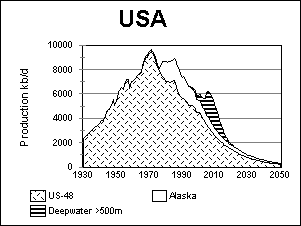
US
Production Curve (with Alaska and deepwater),
courtesy of Colin Campbell.
http://www.asponews.org/ASPO.newsletter.023.php#109
Russia
Daniel Yergin points to Russia as a foil to Middle Eastern oil dominance. However, it is well known that Russian
oil production peaked in 1987.22 Though Russia has boosted its production tremendously in the last few years, it has done
so at a cost. Russian oil is currently much more
expensive to produce than Middle Eastern oil; they
will lose their profit margin if oil prices dip much
below $20/barrel. And the increased production will
result in a much steeper depletion rate. The graph
below was drawn in 1998, before Russia stepped
up production. Now it is likely that the secondary
peak will occur sooner and the downward side of the
production slope will be much steeper. It would be
foolish to bet on Russian oil production to thwart
OPEC beyond 2010.
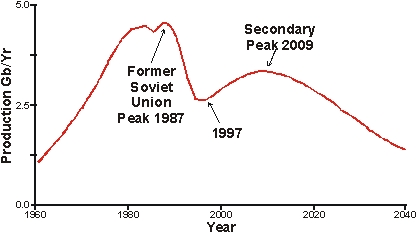
Russian
Production Curve, Duncan & Yougquist, 1998.
http://www.dieoff.com/page133.htm
The Caspian Region—Central Asia
This leaves the much touted Central
Asian—Caspian Sea region. Yet, as I reported last December,
exploration of this area has yielded dismal results.23 The
latest news to add is that Shell Oil is pulling out
of Turkmenistan, following on the heels of Exxon-Mobil.24 Below
is a table comparing EIA figures of proven reserves
with Colin Campbell's figures for total known and future
reserves in four key Central Asian countries. It is
obvious upon reviewing this data that Central
Asia will present no
threat to OPEC hegemony after the OPEC crossover event.
This point is further driven home when we factor in
problems inherent with the Central Asian and Caspian
oil: the problem of transporting it to areas of demand,
and unresolved political squabbles about ownership
of Caspian Sea oil. And dare we mention that most of
the oil discovered in this region has a high sulfur
content, which makes it even less desirable?
|
Country
(in
billions of barrels, Gb) |
EIA
Proven Reserves |
CJ
Campbell Projected Total Reserves |
|
Azerbaijan |
1.2 |
21 |
|
Kazakhstan |
5.4 |
36 |
|
Turkmenistan |
0.546 |
4.4 |
|
Uzbekistan |
0.594 |
2.4 |
|
Total |
7.74 |
63.8 |
Derived
from EIA data (http://www.eia.doe.gov/emeu/cabs/contents.html) & data
supplied by Colin Campbell (http://www.asponews.org/ASPO.newsletter.026.php)
Daniel Yergin claims that new discoveries
will be made, mentioning that every year oil companies
spend billions of dollars searching for new reserves.
Perhaps Mr. Yergin is not aware of all the signs of industry
downsizing.25 Oil exploration had a bumper year for discovery
in 2000 at 24 billion barrels (Gb) of newly discovered
oil. But this figure dipped sharply in 2001 to 16 Gb,
slightly above the ten year average of 14 Gb. The latest
data from BP placed daily world oil consumption at around
75 million bbl/d in 2001.26 That
means that in the year 2001, the world consumed approximately
26.7 Gb of oil, or about 11% more oil than was discovered
in the previous halcyon year of 2000. In 2002, the Executive
Vice-President and Director of Exxon-Mobil (the world's
largest oil company) confirmed that oil discovery peaked
in the 1960s.27
In the last couple of years, many officials
of the oil majors have made coded statements confirming
oil depletion.28 BP admitted the problem of oil depletion by spinning it into
a challenge to develop solar energy.29 Robert
Anderson, the former head of ARCO, said it quite plainly,
stating that the oil industry was “a sunset industry—and
the sun is low in the sky.”30 They say actions speak louder
than words, and in the last few years industry mergers
and layoffs have emphasized these whispered words. Industry
layoffs target exploration and development staff. Shell
has begun the latest round of layoffs, cutting 1,000
exploration & production jobs in its European staff.31
Beyond this, Daniel Yergin falls back
onto the feeble arguments that new technologies will
find oil where none existed before and render previously
unproductive fields economical. There is a modicum of
truth to this. DOFF technology (digital oil field of
the future) will find some more small puddles of oil,
but the big fields have already been mapped, and most
of them have been produced to their peak. DOFF will also
lower the costs of extraction somewhat. But it will also
increase current production from fields and so hasten
their peak and decline.
In the end, we will not find enough
new oil to offset the world oil peak, and little enough
to ameliorate the downward slope. Non-conventional production
is already running into severe cost overruns.32 And, in any case, non-conventional oil will not drastically change
the profile of world energy production, as exemplified
by the first graph in this article.
Mr. Yergin is simply trotting
out a line of disinformation to pacify investors and
the public at large, and to obfuscate the real reasons
for the invasion of Iraq.
A Note on North American Natural Gas
Bloomberg's recently released an article
stating that US natural gas supplies are still severely
depleted. Normally April is the time of year to begin
restocking NG supplies. However, this spring has been
chilly enough in many areas of the country that NG demand
is still up and the restocking of supplies has not yet
commenced. Bloomberg's warns that supplies are so depleted
that it will be hard to prepare for next winter. And
if this summer is hot, summer cooling demand will likely
push NG prices above the record highs of earlier this
year.33
People hoping for an economic recovery
had better hold their breath and pray for a mild winter
next year (and a mild summer this year).